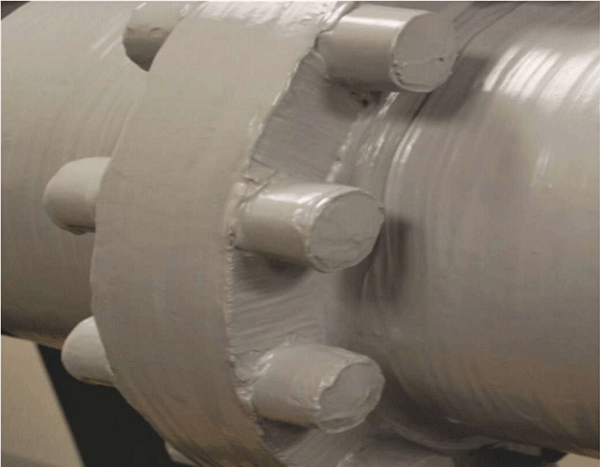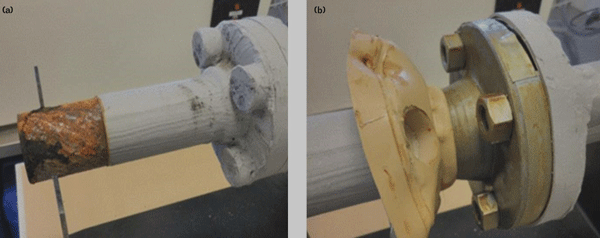Pipes are common pieces of equipment throughout many industries, and wherever there are pipes there are likely to be flanges. An innovative solution has been developed for corrosion protection of flanged couplings. The operating environment to which flanged pipework is subjected can lead to external corrosion, metal loss, and seizing of flange bolts, among other problems. These can result in plant shutdowns, waste of valuable resources, efficiency reduction, and costly maintenance expenses. By using a flexible, liquid-applied elastomeric material that can be peeled off for inspection and then resealed, flanged pipework can be isolated from corrosive environments. This practical solution enables material selection engineers to make informed decisions regarding corrosion protection strategies for flanged pipework.
Flanges are pieces of equipment used for joining together pipe sections and fittings, such as valves. The fluid in the pipe could be a liquid, gas, or slurry depending on the industry. Carbon steels (CS) are among the most common materials of construction and account for ~80% of all vessels used in the industry.1 Flanges are no exceptions, and CS flanges will corrode like other conventional materials if they are exposed to electrolytes. Isolating the flange from aggressive electrolytes is critical for it to function effectively.
Flanges are particularly susceptible to corrosion because of their fundamental design. The void between the flange faces can readily trap moisture, which leads to crevice corrosion. The use of dissimilar metals for the bolts and other fasteners can lead to galvanic corrosion. Weld areas typically are rough and can trap moisture. Additionally, the external surfaces of the flange and connected pipe are often made of CS, and are therefore subject to corrosion. Flange corrosion can be exacerbated by factors such as elevated service temperatures, high humidity, salty marine environments, or pollutant gases. This creates a need for some form of corrosion protection.
This article presents an innovative polymeric solution for the protection of the external surfaces of flanges. While this application focuses primarily on CS, the threats and solutions for other metallic systems are quite similar.
Designing a New Flange Protection Solution
For any external corrosion protection system for flanges to be technically and commercially successful, it needs to fulfill four key requirements:
• Excellent corrosion protection—this is the primary purpose for the design.
• Ease of application/installation—if the solution is difficult to use, then the maintenance personnel responsible will be unlikely to use it.
• The solution has to be suitable for all shapes and sizes of flanges—flanges vary greatly in design and specification, depending on the industry and service conditions.
• Easy bolt access—the solution must allow access to the flange fasteners to accommodate future maintenance requirements.
There are various existing solutions for external protection of flanged couplings, including application of conventional paints, employment of mechanical coverings, use of petrolatum tapes or pastes, application of hot-melt thermoplastic polymers, and flange bagging in conjunction with volatile corrosion inhibitors.2 The new concept uses polymeric encapsulation that provides a peelable and resealable coating system.
The encapsulating system comprises two components: the encapsulating coating and the releaser. The encapsulating coating is a tough, flexible, peelable topcoat that entirely encapsulates the flange and fasteners, thereby excluding moisture and aggressive gases to prevent corrosion. The encapsulating coating is a two-component, solvent-free elastomeric coating designed for brush application onto manually prepared surfaces. Like most elastomers, the encapsulating coating is moisture sensitive and ultraviolet (UV) resistant; but, unlike most elastomers, it is isocyanate-free. Reinforcement tapes are usually used in combination with the encapsulating coating to bridge the void between flanges and at both ends of the repair.
The releaser is a solvent-based, fast-drying, single-component material with a very high coverage rate, making it cost effective. The releaser fulfills two functions: 1) delivering corrosion protection through the use of corrosion inhibitors and 2) providing release properties to enable the encapsulating coating to be peeled back in the event that access to the flange or fasteners is required.
Figures 1 and 2, respectively, show the encapsulating system applied to a flanged coupling and peeled away for inspection purposes.


Experimental Procedure
For this system to be successful, it must provide excellent corrosion protection, be easy to apply, allow easy access to the flanged coupling, and be applicable to all shapes and sizes of flanges. A series of tests was commissioned to confirm that this system is fit for successful service.
Corrosion Resistance Test
The test method in ASTM B1173 is popular for checking corrosion resistance of materials and surface coatings. The apparatus consists of a fog chamber, salt solution reservoir, supply of suitably conditioned compressed air, provision for heating the chamber, and all necessary automation for controlling the test. Although flat, coated panels are normally used in the chamber, the specimen used for this test was a more realistic simulation of a flange section. One half of the flange specimen was covered with releaser and encapsulated, while the other half was coated with a commonly used epoxy in accordance with the manufacturer's recommendations. A portion of the steel pipe that extended outside the epoxy coating was left bare. The specimen was placed in the salt spray chamber. The sodium chloride (NaCl) solution was prepared so that its pH was in the range of 6.5 to 7.2 when atomized at 96 °F (35 °C) and collected. The specimen was exposed to the salt spray for 1,000 h.
Tensile Properties Tests
The purpose of these tests was to determine whether the material was strong and flexible enough to withstand the cutting and peeling-back process. To assess the durability of the new polymer, three tensile properties were measured: tensile strength, elongation, and tear strength.
Tensile strength measures the force required to pull a flexible specimen to the breaking point. Elongation defines how much the specimen elongates with respect to its original length prior to rupture. Both tensile strength and elongation were determined in accordance with ASTM D4124 and D624.5 Samples of cured encapsulated coating shaped as a dog bone and a dumbbell with and without reinforcement tape were placed in a tensometer for testing. Tear strength, on the other hand, measures the force required to tear the specimen across its entire width. Specimens of cured encapsulating material with and without reinforcement tape were also tested for tear strength in the tensometer. The results of these tests were benchmarked against those obtained for a formulated acrylic ester copolymer roofing emulsion that is well-established in the market.
Peel Adhesion Test
Although the encapsulating topcoat effectively free floats over areas treated with the releaser, it is critical that it bonds tenaciously onto the pipe where the repair terminates in order to prevent moisture creeping under the edge of the repair. The ASTM D4296 peel adhesion test is typically employed to quantitatively assess the adhesion of flexible coatings on rigid substrates. The test actually measures the force required to peel the coating from the substrate when pulled at a 90-degree angle with respect to the substrate.
Because the encapsulating material was specifically designed for application onto surfaces manually prepared according to SSPC-SP 2,7 it was applied onto three different substrates for this test—manually prepared rusty steel, and manually prepared epoxy and polyurethane (PUR) coatings. The coatings simulated the maintenance paints that are commonly present on pipework in the real world. The adhesion failure mode, whether cohesive or adhesive, was recorded.
Heat Aging Test
It is important to evaluate the aging resistance of the system because repairs may be in service for many years. Resistance to heat aging was evaluated by exposing the system to 140 °F (60 °C) temperatures for five months. Upon completion, the system was again tested for tensile strength, elongation, and tear strength in accordance with ASTM D412. The results were compared to those obtained from a control sample left at 68 °F (20 °C) for the same duration of the test.
Results and Discussion

Corrosion Resistance
Upon completion of the 1,000-h test in a salt fog atmosphere at 96 °F, the specimens were inspected. The salt spray cabinet had created a very aggressive environment that could rapidly damage unprotected steel. Figure 3(a) shows that the end of the uncoated pipe was severely corroded. However, when the encapsulation was cut open, the substrate underneath showed no sign of corrosion. Although some brown staining is seen in Figure 3(b), this was attributed to the releaser and not to corrosion.
Tensile Properties
The results obtained from testing the encapsulating coating with and without reinforcement tape are shown in Table 1. Tensile properties of a well-established reinforced roofing emulsion system are also displayed for comparison.

The results confirm that the performance of the cured reinforced encapsulating coating is similar to that of a proven roofing system. As expected, the reinforced encapsulating coating is more resistant to tension than the unreinforced material. Therefore, the system is strong and flexible enough to withstand the cutting and peeling-back process.
Peel Adhesion
Table 2 shows the results of peel adhesion of the encapsulating coating when applied onto the three different substrates.
These results show that in all three cases the encapsulating coating failed cohesively rather than adhesively. This means that adhesion to all three substrates was greater than the internal strength of the polymer itself; therefore, the adhesive strength was actually greater than the values shown. This demonstrates that the system offers excellent adhesion on the key substrates involved in flange repair.

Aging Resistance
Table 3 shows the measured tensile properties of the encapsulating system after exposure to a temperature of 140 °F
(60 °C)
and a control sample exposed to 68 °F
(20 °C).

As the test results show, the cured properties of the encapsulating system before and after exposure to 140 °F (60 °C) for five months are almost identical. This demonstrates that this solution will be acceptable for use at temperatures up to 194 °F
(90 °C).
Conclusions
The innovative encapsulating system includes several key features:
• The system is quick and easy to apply.
• Any shape or size of flange can be protected because it is a liquid-applied system.
• The system offers excellent corrosion protection via the use of a corrosion inhibitor/releaser in conjunction with the encapsulating material.
• The system is peelable and resealable so that fasteners can be accessed.
• The system is applied with simple tools, without the need for an elaborate application process.
• Grit-blasting of the substrate is not required for good adhesion.
• The system offers excellent resistance to UV and weathering, and very good resistance to heat aging.
References
1 C.P. Dillon, Corrosion Control in the Chemical Process Industries (New York, NY: McGraw Hill Book Co., 1986).
2 M. Prenosil, “Volatile Corrosion Inhibitor Coatings, VCI Corrosion Control,” Supplement to MP 40, 1 (2001): pp. 14-17.
3 ASTM B117-11, “Standard Practice for Operating Salt Spray (Fog) Apparatus” (West Conshohocken, PA: ASTM International).
4 ASTM D412-06a (2013), “Standard Test Methods for Vulcanized Rubber and Thermoplastic Elastomers—Tension” (West Conshohocken, PA: ASTM International).
5 ASTM D624-12, “Standard Test Method for Tear Strength of Conventional Vulcanized Rubber and Thermoplastic Elastomers” (West Conshohocken, PA: ASTM International).
6 ASTM D429-14, “Standard Test Methods for Rubber Property—Adhesion to Rigid Substrates” (West Conshohocken, PA: ASTM International).
7 SSPC-SP 2, “Hand Tool Cleaning” (Pittsburgh, PA: SSPC, 2004).